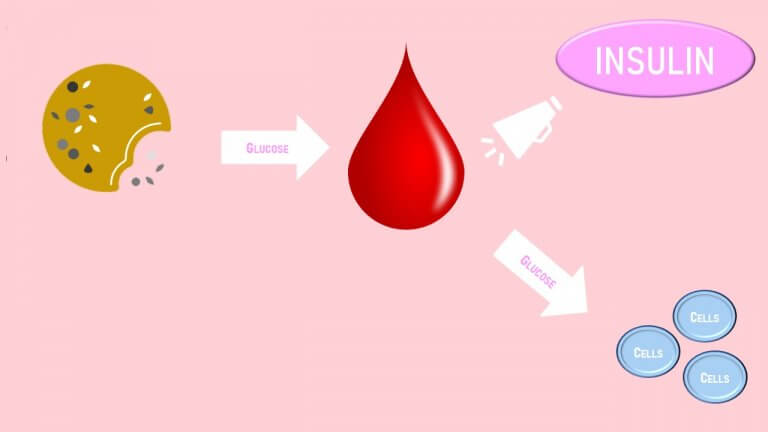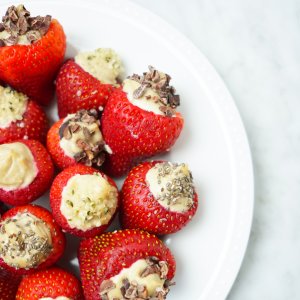California Strawberries is participating in November’s National Diabetes Month by providing our readers with education and recipes related to diabetes prevention.
2020 has taught us that underlying conditions like diabetes can increase the severity of other infections like COVID-19. It’s important to understand what diabetes is, how diet plays a positive role, and how to eat to manage blood sugars.
What is diabetes?
When people without diabetes eat carbohydrates, the body breaks down carbs into glucose. Glucose is released into the bloodstream creating a spike in blood sugar. The blood sugar levels go back down when insulin signals the glucose to leave the blood and enter our cells. Then our cells can use the glucose for energy.

Type 1 Diabetes
In type 1 diabetes, the body does not produce insulin. Therefore, glucose stays in the blood at high levels. Type 1 diabetes can happen to anyone at any age in any condition. With insulin treatment, medication, exercise, and thoughtful eating habits, type 1 diabetes can be well managed.
Type 2 Diabetes Mellitus (T2DM)
In type 2 diabetes mellitus (T2DM), the body continues to produce insulin, but insulin’s signal telling glucose to enter the cells becomes weaker and weaker over time. As a result, more insulin is released to compensate for that weakened signal, but the blood sugar levels gradually rise. Eventually, like losing our voice after shouting for a long time, the insulin signal gets tired, and stops altogether; the beta cells that make insulin may ultimately be destroyed; and blood sugars can surge to dangerously high levels without treatment at hand.
Type 2 is the most common form of diabetes. While it can happen to anyone, it is more prevalent in certain demographics and those who have other risk factors like overweight, obesity, a family history of diabetes, heart disease, or gestational diabetes.
Managing Your Risk for Diabetes
You can take a 1-minute T2DM risk assessment here.
The American Diabetes Association (ADA) says that no matter where you are with T2DM, lifestyle can have a major impact on its development. Diet and fitness are keys to managing it.
Eating Strawberries May Decrease Risk of Developing T2DM
The three studies below suggest that eating strawberries frequently may be one way diet can play a positive role in preventing or managing diabetes.

Study 1: Can a strawberry snack offset the effects of a Western-style meal a few hours later?
Western-style meals are typically high in calories, saturated fats, and sugar, and low in vitamins and minerals (think bacon, pancakes, and syrup). Eating these types of meals regularly stresses our bodies and puts us at risk for chronic diseases like T2DM.
According to a study in Food & Function, scientists asked 14 overweight adults to consume a strawberry drink (equal to about 1 cup of fresh strawberries) at one of three times: 2 hours before a typical Western breakfast, with the meal, or 2 hours after the meal.
Those who drank the strawberry beverage two hours before breakfast had significantly lower blood glucose levels over a 10-hour period versus those who had it with the meal. The researchers think that strawberries may improve the insulin signal, moving glucose out of the bloodstream and more quickly into cells.
Bottom Line: Eating strawberries may help reduce blood sugar levels and inflammation, especially when consumed within two hours of a meal.
Study 2: Data from the Women’s Health Study showed that compared to women who rarely or never ate strawberries, those who ate at least two servings of strawberries each week had a 10% lower risk of developing diabetes.
Researchers also found that women who ate fewer servings of strawberries were more likely to have higher hemoglobin A1c levels, increasing their risk for T2DM.
Bottom line: Eating 2 or more cups of strawberries per week may decrease a woman’s risk of T2DM by 10%.

Study 3: Another review showed that eating more anthocyanin-rich foods may reduce the risk of T2DM. Anthocyanins are the nutrients responsible for the red, purple, and blue colors in vegetables and fruits such as strawberries.
Anthocyanins may reduce inflammation, oxidative stress, and insulin resistance- risk factors for T2DM.
Bottom line: About 1.5 cups of strawberries per day could reduce the risk of T2DM by 5%.
Strawberry Recipes to Prevent Blood Sugar Spikes
A serving of 8 strawberries has a little under 8g of sugar and less than 50 calories. In fact, the ADA website has strawberries on their “Diabetes Superfoods” page because they are packed with antioxidants, vitamins, and fiber.
Maybe you’re convinced that eating more vegetables and fruits like strawberries could help reduce the risk for T2DM, but you need more delicious ways to enjoy your 8 strawberries a day. Here are three fun, low-sugar recipes that incorporate strawberries and protein in new ways for National Diabetes Month:



